
















Drought-stressed grasslands have cured to fields of crisps. Forest trees have shed needles and cones in a desperate attempt to retain moisture.
Their roots thrust ever deeper in search of subterranean springs, but these are now dry. Creeks, seeps and swamps have evaporated – the land is parched and devoid of green. Little mammals, unable to travel as far as the distant river, have died of thirst. Their carcasses so dehydrated they provided a mere jerky-style snack for scavengers. Not even maggots will find a feast here.
Land-locked eels writhe in tiny, diminished pools flushed green with algae and devoid of oxygen. They bake alive in the noon day sun, oozing slime and ever hopeful of relief from above. Alas it is not welcome rain which drops in, but harrier hawks.
More mobile freerange animals have migrated toward permanent ponds and dwindling rivers. There is life-giving water here but minimal feed. Concentrated at these sites they are vulnerable too. Vulnerable to the predation of opportunists like me and my kind. Autumn will be upon us soon, don’t despair, we’re nearly there. Darkness settles earlier now, and dawn arrives later, and cooler too. It’s these
cool mornings which draw me out. They are the amber light, which is the signal to get ready to start another season of dogging hogs.
Time now to cautiously prod summer in the arse and bid her ‘bon voyage.’ Time to take the canines on carefully managed micro-hunts. To gradually improve their fitness, whilst taking great care to dodge the dreaded heat.
Knowing, all the while, it will be these early hunts most likely to result in over-zealous dogs getting hurt or killed. It happens. There is a newcomer to my boy brigade.
A whiskery wee lad, just a novice, new to all things hunting. He who struts with whitetipped tail held high and investigates every scent. He who tastetests every variety of animal faeces and bird droppings. Boston (not Austin) Powers - all 20 centimetres high x 40 centimetres long of him. Dawn is easing into
a bright and still day when Boston joins the real dogs and I on our Big Day Out. He instinctively follows their lead, part of the tiny pack, which consists of just two pig dogs and their human. This morning every one of his senses are activated - everything is an adventure - everything is a joy to be savoured – especially those faeces.
Before the lateFebruary sun rises above the forest shadows Chop and Nugget work o their pre-season enthusiasm. They progress from willnilly to sense and sensibility. Then settle comfortably to working sign and following leads till, eventually, they’re rewarded by finding the hot trail of a boar. He has recently taken a last drink before venturing back towards his daytime bed.
While Nugget streaks o at warp speed, Chop keeps his nose to every cloven-hoofed footfall on the trail;
Kim Swanincluding the deviation where the boar had heard his pursuers and sidestepped. Chop sidesteps too. He turns left, nose down, eyes up, 100 metres ahead his quarry stands quietly, readying for a showdown.
From below I see glimpses through the mature trees. Nugget streaking up hill. Chop, slower, deviating then accelerating. Chop’s howdy-do sounds impressive, so impressive, Nugget is at his side within seconds and then the showdown begins. It is now I fear for my dogs’ safety.
He’s small, is Boris, but for all he lacks in size he more than compensates for with ferocity. His tusks are long and sharp - his entire frame is long and sharp - he is an ugly European-type boar with attitude issues, and much to my surprise and relief, both dogs treat him with respect.
All the while Boston


has listened to proceedings with great interest, and now his big buddies are bailing, he’s keen to investigate. He goes ahead, confidently at first, up through the blackberry tangles via a network of possum runs. As we get into the zone and the action is punctuated with the boar sco ng and spinning on attack, the wee dog hesitates. From a safe distance he watches the big dogs duck and dive, keeping their quarry contained, and then he readies for action.
With a look over his shoulder Boston, middle name Danger, leads me in. Every hair on his body and tail stands on end till he resembles a bottlebrush on 10-centimetre legs. From deep down in his tiny little chest a growl rattles, he sounds fearsome, but I know otherwise.
In real close, the 7mm-08 o ers up its voice and at once
Nugget and Chop secure the boar. Boston does no such thing. Unperturbed by the roar of the rifle discharge, he stands stock still, still in bottlebrush mode. He observes the tangled trio but is not tempted to join in. Not this time. Afterwards, when the boar lies still and the big dogs get pats and praise, Boston carefully sni s the site and the carcass. He is cautious, but not afraid. Chop and Nugget have proved to be cautious too, the first hazard of the new season now safely behind them. We’ll be ready when the amber light turns green. Roll on autumn, and yet another season of dogging hogs. Roll on the initiation of Boston Powers too – he and I together - more adventures and joys and savouring of all things, except faeces!

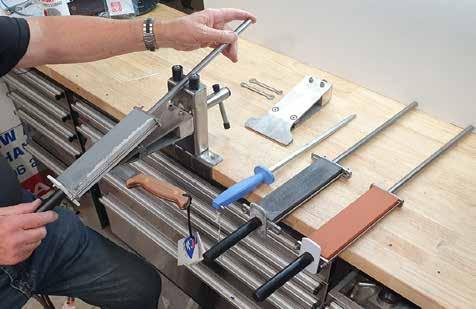

Mason Allan turned 11 on the 25th January. The next day, he was out on the boat fishing with his Dad. His goal was to catch a snapper bigger than the 12lb specimen his younger brother Braxton had caught earlier that week. Still, he never imagined he would end up catching himself a special birthday fish……
A 20.5lb snapper!
The reel screamed as the monster snapper took the bait. An epic fight lasting around 10 mins ensues, Mason losing line as fast as he could gain it and at times barely able to hold onto the rod. But Mason kept his cool and dug deep. Luckily, his little reel was up to the task, and once Mason engaged the low gear, the fish eventually tired and
Gary Allan
Lauren has had a very interesting and rewarding time with her big game fishing hobby.
“I have a very large passion for game fishing. I have been catching and tagging sharks since I was 13 -the largest being 210kgs. I am a New Zealand Women’s record holder for the largest short bill spearfish caught in NZ (and have held this title since 2019). I also held the title for the most gamefish caught by a female junior angler in 2017. I also hold the title of 1000th Marlin caught for our boat.”
In 2023 Lauren took that passion and enthusiasm she showed for game fishing and applied it to her dream career
"Clicking the 'submit application' button (for my police recruit application) at a young age was daunting, I would tell everyone I was thinking about applying or I was getting fit to apply but it took me about a year of saying it until I actually did. I was very nervous about not being taken seriously and had many underlying thoughts that I didn't have the life experience that

the police look for during the application process because of my age. My best advice is once you've hit that button, put 100% into everything - your running, your study, your interview, and your scope.

The thought that stuck with me is, if I'm here in this process there is someone who
isn't, who wants this even more than I do. The challenge starts when you open that browser, so be ready and have a supportive group of people that are willing to help you across the finish line. Rely on your friends, talk about the process with them, get excited about the little things and just take the leap. You're doing this for you.”
Laura was one of 51 o cers to graduate in late February 2024.
slowly came closer and closer to the boat. As it neared the surface, the excitement was immense, and the net man, was suddenly under more pressure than Eddie Jones at last year’s Rugby World Cup,.Fortunately for Mason, the net man was up to the task, and the fish was swiftly scooped out of the water and onto the boat. There were cheers, high-fives, and
hugs all around. Mason was shaking and in shock. Everyone on board was stoked and amazed. Such a special moment for Mason and for Dad Gary to be there to witness his son catching, for most fishermen, a bucket list dream fish. Caught on a 7/0 black magic snapper snack.
Mason’s next goal is to shoot a kingfish!
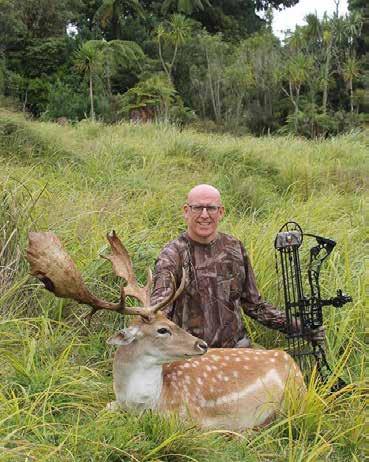




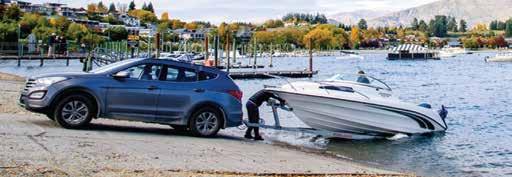



Nathan Hines from Timaru fishes solo in the mixed fishery in the Canterbury Bight. He skippers Latham Bay, a 12m trawler. He's 41 years old and has been in the industry since he was 16 and straight out of school. He is a dad to two, including a new baby who is just three weeks old.
If I had one thing I'd really like people to know about the life of a fisherman, it's what a good life it can be. If you're prepared to roll your sleeves up and do some hard graft, it's such a rewarding and enjoyable lifestyle that a land job would struggle to match. That is something that always rings true when I think of my time so far.
That's not to say it's easy. It is tough out there right now. My turnover each year is my wage. Costs are high. Any extra compliance costs mean bread o my table. It's not just compliance costs; it's everything; everything has been up in the last three years. Berthage fees go up every year. Even the cost of anti-foul has tripled in the previous
three years. Don't even want to mention fuel. But the price we get for fish has yet to keep pace. I go into the supermarket and see a whole kahawai for $20; well, I get $1 of that. And that's not including the cost to catch. And I think in fishing, we feel it's death by 1,000 cuts. When I started this business, there were nine day-fishermen in Timaru. A decade later, there are just two of us. When you think about that, it makes you wonder if the end is inevitable.
But it's an awesome profession. I love it. I will do it for as long as I can. I do it because of the call of the sea. It's the anticipation of the catch. It's the same excitement as catching a big fish on a rod. Every time you haul up the bag, it's exciting. It's also beautiful out there. When I'm out, and I get that view of Mt Cook poking out of the clouds, you can't beat that. It's a nice feeling.
I've got a background in net making as well as fishing. After my first 14 months at sea as a teenager, I went to the

net sheds and learnt to build trawl nets. This gave me a skeleton key to the industry because every skipper wants you when you have those skills. And
want to avoid catching small fish. If I can leave them in the water, then they get more breeding seasons. The new gear is good for the industry as a whole; if we're

even now, I am building nets for several people in the industry. I've experimented with designing di erent net types, mesh sizes and orientations to reduce bycatch.
I'm not paid to catch shells and sand and
The mission began for 7 year old Max Harwood setting o from Port Nelson.
Max was very focussed and determined to catch his first albacore tuna to add to his species list for his Dawnbreakers Fishing Club competition. We took some big gear out with us to make it easier for him if he managed to hook a big fish. We headed out to the Eastern side of the bay towards Okiwi Bay/Durville Island after we
into how Hector's dolphins interact with trawl gear. The study was funded by MPI. I worked alongside Jasco Applied Sciences on the design and placement of hydrophone equipment on my trawl doors, then was left to go about my fishing. I spent 23 sea days with the equipment listening to and recording the dolphins so we could count and locate them and monitor their activities.
We love seeing the dolphins out there. I always fish around them; I call them my fishing buddies. They are very smart and know how to use the trawl vessels to help get their own catch. But we never want to catch one. I've never caught a dolphin, although the risk is always there.
all reducing bycatch, it helps everyone. It also helps improve fuel e ciency. I feel like I've got the right net design nailed now, but there are always things to tinker with.
I've also been involved in a study
received some friendly intel of tuna being caught in the area. We steamed to the 50m contour line and set the gear, 5 lures out behind the boat, and we were fishing. There was a lazy northwest swell rolling in, after an hour, this unfortunately got the better of Max and made him seasick. He was not giving up! We got a call from a friend who was fishing on the other side of the bay who had managed to catch an albacore, so
about finding a way to ensure their safety but not push them out of the area. It was interesting stu , but more funding is needed to develop a remote dolphin dissuader device that keeps dolphins away from the gear at times of high risk.
As I said, we don't want to push the dolphins out, but we don't want to be pushed out, either. The talk about new marine reserves that comes up every year or two is very stressful. As an artisan-style day-trawler, if these reserves they've been talking about go ahead, it would be the end for me, and that has a significant impact. It nearly tears the eye because I love fishing and want to keep doing it.
Dolphins are bloody intelligent and fast, so the risk to them, for the most part, is low. It's when we make a change, like when we haul/shoot the gear or when we turn, that the risk increases. Part of the study was to look at how e ective the dolphin dissuader device is at keeping dolphins away. It's
we pulled in the gear and headed over that way. The conditions were much better over that side of the bay and with the promising information of a fish being caught, this perked Max up.
After 20 mins towing lures on a much calmer western side of Tasman Bay, Anton saw some fish busting up, so we turned the boat to cut in front of them. No sooner had Anton put the lures past the fish, BOOM the starboard
outrigger went and Max had a fish on! Max leaped into action, grabbed the rod and started reeling.
After a short fight, he had the fish boat side and landed! Max was ready with his Dawnbreakers card and measure mat to make the catch o cial for club points. He gave the tuna a quick pat on the head before dispatching and bleeding the fish and getting it straight into a slurry of salt ice. Max was
For a young person getting into fishing, the opportunity is massive. If you keep clean, learn everything you can, add that seatime up and get those tickets, you can aim for the driver's seat. That is the best seat in the house
absolutely chu ed to achieve his target catch after battling sea sickness and a slow start, his determination is outstanding! Just the one tuna caught on this trip but lots of smiles from Max, he was very proud! A big lesson learnt that no fish is guaranteed, and patience is a must.
There are still a few species to tick o for Max this season, he is excited and determined for his next fishing trip!
Usually, fishing is very much an activity where you use as much of your experience as possible to determine what is going on when you send a bait or lure down to the bottom of the ocean.
What I found out recently, after sending a camera down with my baits, is that we could be completely wrong about what is actually occurring.
Using a bracket made of stainless steel and tipped with wire for safety, I screwed in my Sony action camera to begin prospecting spots with some baits underneath. I hoped to capture both the sub sea structure and the fish that live below.
Pretty quickly, I had captured bites of several species like tarakihi and snapper, seeing kingfish
cruising past in places I wouldn’t have expected and many more species I had no idea were on the spots I was fishing. The footage was particularly beneficial in looking at the reefs I was fishing and helping me understand what my sounder told me. The sign over reefs no longer were unknown fish, they were leatherjackets and butterfly perch.
When I reeled in my hooks to see no baits left after not feeling a bite, I discovered that leatherjackets had sneakily chewed around the hook to remove it.
When I was catching no fish in a spot where I expected to get bites, tarakihi was swirling all around but not feeding!
A john dory even swam past, checking out my hooks before attempting to eat one
of the smaller tarakihis. Just eye-opening stu ! On another day, while trying to film a kahawai biting a spinner trolled behind the camera, a decent-sized mako shark rolled into the frame, speeding up into the frame and looking at what was happening. He had a test bite of the bracket and seemed very interested in the small lure. The shark followed for over 3 minutes before turning away back into the deep. I had no idea the shark was even there until I went home and reviewed the footage! One of the fish I had terrible luck filming was red gurnard; for weeks, I had tried with little to show for my e orts. On a drift on the way home, I managed to get a glimpse of how these fish hunt. So, for the next trip, I set to target a few with the


asman Bay 8kg Bait Box
Bullet Tuna (Baby Bonito)
Barracouta Sides approx 2kg
Arrow Squid Premium Grade 100-200g
Arrow Squid Bait Ungraded
Trevally Skin on Fillets
Tuna & Squid Burley Bombs approx 2kg
camera recording on the bottom.
I captured some amazing shots of gurnard feeding in various ways; some smashed into the bait without thinking, and others were more cautious. The detail I learned most from this footage is that one gurnard eating food means others will come in to try and compete. Several times, I hooked a gurnard, and then from nowhere, a second

would either try and steal the bait or grab the second one.
I look forward to capturing more species on my

camera and learning more about what happens while the line is down there in the unknown.
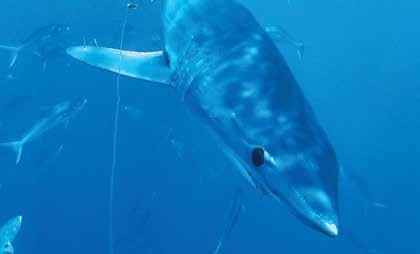

The sole purpose of my life is to be free to sit in proud display above a top lip - Mo. The sun is shining, a gentle breeze stirring in its warmth, all is right in the world. Excitement simmering in the background. Anticipation. The promise of another adventure.
Mo felt eager to explore this day. An assurance of fun, the thrill of controlled danger. Salt air, cold ocean, bright sunlight, new experiences. Mo was going spearfishing.
Imagination running wild, reality giving way to the hope of expectation. Limitless blue water. Fish, turtles, whales, mermaids?! Who can say what might be discovered deep below the surface?
Impatience, suspense, Mo quivered as only a moustache can, “hurry up!”
Suits, masks, fins, spears, weights, lines, knife, so much gear, so much preparation. Mo recognised none of this. Simply the frustration borne from ignorance.
Boat connected to car, and we were o ! Music, a winding road, laughter. Glimpses of the ocean, it sparkled like a jewel on the horizon.
Beach, shore, waves
kissing sand, on the boat now. Wind in hair, sun on face, eyes reflecting light as it ripples of the water. Sensing calmness, it tries to slow the body in preparation to dive.
Today Mo was at the spat farms – shellfish seeded onto lines, suspended into the depths. Mussell buoys. Rocking on the ocean swell. Gulls. Circling overhead. Fat seals. Lazing in the sunshine and fish - the BIGGEST KINGFISH that ever existed. Simply waiting there. Wanting to be speared and wrestled on to the boat. Let’s go!
Mo loved to swim. Loved the ocean. Sensations, freedom found within the swirl of the water. Weightlessness. Surrounded by a vastness yet feeling connected to it all.
Dive flag, crackling in the breeze. Spear, clipped to line. Line, clipped to float. Suit snug and fitted. Fins, embracing feet. Gloves, intimate with finger. Weight belt, hugging hips. Almost claustrophobic yet perfectly so but then, so rude! The indignation! A mask strapped tight to the face. Mo, crushed into darkness. Restrained between skin and rubber.
“How dare you?!”
The unheard voice of Mo cried needlessly


into the black. A shock of breath, clamped o during the backwards fall into the water. Calmness being brought into reality, as the body relaxes into its new surroundings. A steadying of the heartbeat. Slow powerful kicks with long fins. Eyes of the hunter roaming along the mussel lines in search of its prey.
Slip below the waves
and feel the pressure of the water starting to compress. Let the surface drift away. Amazing. Mo hated this. Unable to see. Unable to hear. Unable to feel. Unable to experience. Freedom. Mo wanted freedom!
So, Mo bristled out below the lip of the mask. Breaking the seal. Breaking free. Up to the surface again, water flooding into the
space between face and glass. Mask tilted o to let the water drain.
“Yes, freedom at last!”
Then a firm tug on the straps. A tighter seal against the skin. Twice more repeated, the fight between the wearer and Mo’s desire to be free.
No whales were seen. Nor turtles or mermaids. Nothing could
be seen or experienced except the tight discomfort of darkness.
Mo did not observe the silver schools of fish, shimmering as they swam the currents of the ocean.
Mo could not see the play of light that filtered through the chain jellyfish like slow motes of dust, drifting on the sunshine. Mo missed the thrill of excitement as a kingfish swam into view. The battle between fish and diver as the line ran taut between the two. The primal passion of the hunt, while knowing respect towards Moana and the gifts of the creatures within.
Mo only knew darkness. Annoyance. Discomfort. Fear.
The diver experienced light and shadow. Weightless wonder within slow movements. The comfort of being surrounded by the vastness of the seas, while feeling connected to it. The joy of the living as fear is replaced with freedom. A fish on the boat. A smile on the face. Happiness in the soul. Appreciation in the heart.
Mo left the house it knew that night, packed its bags and moved on. Preferring instead, to swirl down the drain under the sharpness of a razor.







The searing African heat was fuelled by a gentle zephyr that caused the dry savanna grasses to rustle, hustle and murmur. Africa whispers to you— constantly.
Hunting the dark Continent is subtle cnd layered… if you do it right. My eyes meandered across the textured landscape of the Greater Karoo; a once prehistoric inland sea that subsided with time, leaving raw earth that was then sculpted by the wind in the hand of millennia to create a Leonardolike masterpiece: elephantine rock statues built from blocks that could have been left over from the pyramids, the topography laminated then chiselled by intermittent watering, and orphaned mesas that add a hint of melancholy—Mona Lisa.
Having hosted many Kiwi hunters over the
past decade, I have learned one valuable lesson; treat Africa right and she smiles on you—disrespect her and she bites!
My first trip to the Karoo saw me take an ancient free range kudu, a magnificent old mountain reedbuck and a gigantic tiny steenbuck on the one day—a trifecta. Unforgettable.
Already, on my return to the Karoo, I had taken a wily old red hartebeest and an incredible black springbok. Both exceptional trophies. But neither came easy; I had to work hard for them—Africa likes that. But I didn’t want to tempt fate. I couldn’t possibly hope for a third outstanding animal—again—could I?
I looked through the heat haze at the herd of springbok quietly grazing in the distance.“There’s a copper to the left,” my
Daryl CrimpPH Pete said. “Looks reasonable.”
He was referring to the size of the horns. On a springbok, you look for big bases— always big bases— and plenty of height with hooks that curve back. I couldn’t tell. It was too far and the shimmering air made the perfect excuse for waning eyesight.
“Let’s go!”
Dropping out of sight, we ‘circumnavigated East Cape’ to get the wind right and eventually found ourselves at the base of an escarpment. Climbing in the heat over cobbles and uneven ground was tough but Africa likes to test you.
Cresting the top, we took a breather as we scanned the plateau,

The hunt was on—not that it was ever o .
We’d already clocked over 15km on foot looking for a decent animal and, now that we’d found one, Pete wanted me to take the long way round to get to it!

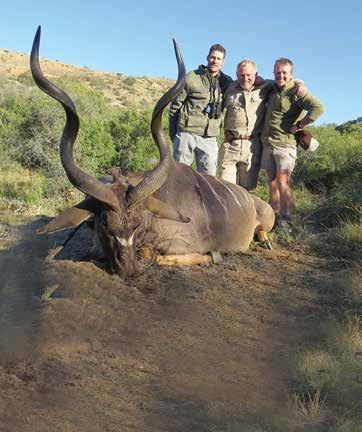
hoping the herd hadn’t vanished. We were in luck. They hadn’t moved far but were still over 300m away—and there wasn’t a skerrick of cover. Moving in tight Indian file, we inched closer, freezing every time a head
lifted. Then o again at a creep. In this painstaking manner, we closed the gap to 80m. Then Pete decided to get closer!
“I don’t trust your shooting,” he jibed. Bastard!
At 60m he sat me on an ant hill and positioned the sticks. I cradled the .300 Win Mag, chambered a round and found the buck through the Swarovski glass. Then squeezed the trigger— no hesitation.
Walking up to the fallen animal, I was stunned; I couldn’t have dreamed of a
more magnificent trophy. Not only was he an old campaigner, but he was the biggest buck ever taken on the property. Words seemed superfluous.
In the tradition of the San bushmen, I knelt and plucked some tail hairs from the old buck. Then, to help spirit it into the next realm, I cast them upon the hot breeze. As they floated o , the wind whispered and I shivered.
Africa smiled.
I’d hunted right.

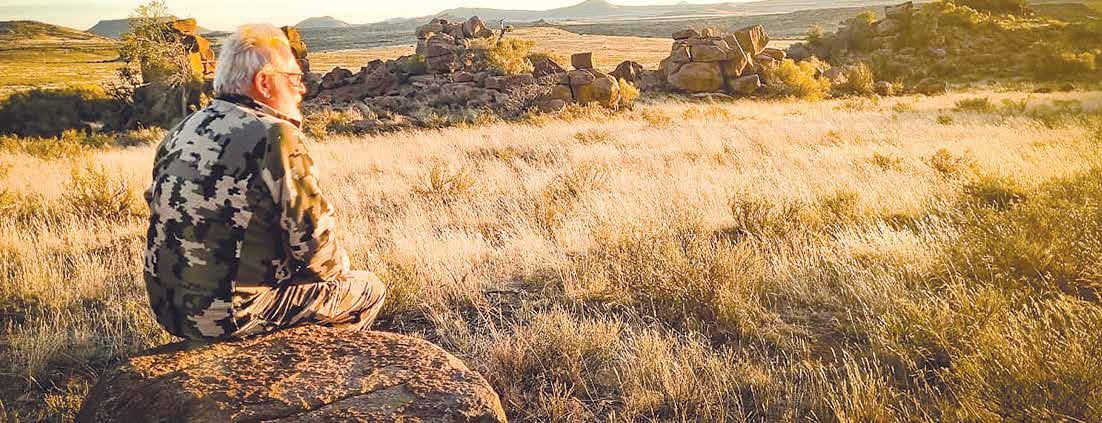




Licence Shooting in New Zealand has been under much pressure over the last few years. The problem I see is that while those in power and places of authority have been concentrating on the honest and licenced holders, they haven’t done as much as they could to stop the criminals that use their firearms as weapons and not sporting equipment. We have been saying that most of the law changes and restrictions were aimed at the lawabiding people and would not deter the dishonest.
The register has been getting a lot of talk, with one side saying it will fix everything, while the other side, the licence side, says it is a waste of money and resources. The problem for the police is that the evidence supplied by the police
as a result of an OIA (O cial Information Act) backs up that it is a waste and won’t do any reasonable good. Even though the police and their Union rep have been blaming the licence holder for being the primary source that the criminals and Gangs use to get their weapons, it’s just not true, and they know it. It doesn’t take a brain surgeon to understand that people who can
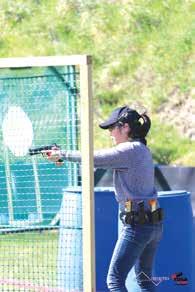
import drugs in vast quantities would have no problem getting all the firearms that they want. I wouldn’t be surprised if they don’t even order some or pay for them, face it if you’re going to supply several million in drugs, you would want them safe, so throwing a few guns in as a bonus wouldn’t break the bank. So it stands to reason that there are more weapons. How do we know? Well, what the police have failed to admit, or the media just didn’t report, is that when a firearm comes into the country through legal channels, there are a couple of must-dos. First, customs, then the police seize it, then confiscate it; in other words, it’s gone. First,
After 10 years in the industry in Marlborough, Pete & Ange Walters are bringing to the Nelson Richmond area, NZ’s newest YAMAHA dealership – NELSON MARINE CENTRE
(NMC) – due to open April 2024.
Having led a team that took Marine & Outdoors to the heights of “YAMAHA Overall Dealer of The Year” in 2023, they’ve decided that the time is right to bring some energy, and a suite of quality products to the area.
Utilising the YAMAHA range of Outboards, Waverunner (Jet Skis), Genuine Parts and Accessories, as well as a quality range of other boating marine safety & maintenance product, under the Boating & Outdoors
umbrella, they are sure to have what you need.
Together with Mark Wiblin (Operations Manager), NMC will operate with a showroom & service centre from 23 McGlashen St, Richmond. With an extensive technical knowledge
in the market. We are determined to bring to Nelson some energy and a customer service experience not seen


through strong factory backed training, and a huge customer service focus, both Pete & Mark are excited at the opportunity ahead.
“We’re already over here regularly for service work & we’ve really spotted a gap
an import permit is required, which comes from the police. Then, if you have one of those, it has to be taken and shown to the police when it arrives. So, police have known all along what legal firearms are brought into New Zealand. Now we wait and see if National are good to their word because when you do a cost analysis of the register, it doesn’t add up as a benefit; it’s more of a money pit. The register will cost us over a billion dollars over the next 10 years. Just think what good that kind of money would do in new medical drugs not covered now, or new beds in hospitals. Maybe fixing some roads; think of all the lives that could be saved or improved upon for people. When I said licence holders are against change, let me be very clear: if it will improve public safety, then go for it, but
we want it based on evidence, not just feelings or emotions.

Brian Bishop
I have been a pistol shooter for 30 years, which I took up due to wanting to shoot more because, as a hunter, I was piss poor. I have been lucky enough to have shot many times as a representative for New Zealand, thanks to a very understanding wife as the cost to travel is covered by us. I shoot IPSC (International Practical Shooting Confederation), which is action-filled where speed and movement are required. My competition pistol is an Open Chaos, built at Gun Supplies in Rotorua for me. I used to shoot 3gun as well before the ban, but the loss of my competition guns stopped this. However, with some luck and common sense, we may get our AR15s back for competitions. I have been on the executive board for Pistol New Zealand and COLFO for some time. I did this to give back to a sport that has given me so much, but also, in the last few years, to fight for our rights as licence holders. I am thankful to be allowed to state my views to so many here, and I hope it gets people thinking. Please note my articles are my personal opinion.


for a very long time in Nelson” says Pete. So if it’s a lifejacket you need, an outboard service, you have a pesky running issue on your engine, or if you’re just contemplating that long awaited Jet Ski for the family or yourself, the team will be here for you and ready to “Fuel that Adventure!!”
• The first is suitable for 22 Hornet through to 243 including, 222, 223, 22-250, 243.
• The second suppressor is suitable for 6.5 through to 30-06 including 6.5 prc, 270, 7mm-08, 284, 280, 308, 7.62 x 39 etc (not including 300 PRC or belted magnums).
• 9” in length (230mm), sits 4” forward & 5” back over the barrel (this is a “fixed” length and cannot be changed or added to)
• Weight 360 – 370grams (alu internal muzzlebrake 5-6,000 rnds)
• Colour - Black
We have two multi calibre suppressors available in the hybrid model and this is possible because the hybrid ba e system has tight tolerances allowing the small ranges of calibre. The hybrid ba e system also lowers the risk of stray bullets and bullet strike www.GUNWORKS.co.nz
The 41mm 9” suppressor is most suited for those who like to clean their suppressor.
I am a keen fisherman, so when the summer holidays came around I was very excited as I intended to go fishing quite frequently.
I watch a lot of NBA, so I thought of our holidays as more of an o season, in which we got a break from school, and a chance to relax and do what we want.
This article is just going to feature a few highlights of our success from this oseason.
I fished at a jetty in Blu a few times with my grandpa, where we found that hundreds of small blue cod lived underneath the jetty that provided a source of food for bigger fish passing by, as well as the occasional stingray. On one particular trip just before Christmas, I hooked into a beast of a fish which almost pulled my rod o
Finn Meijer
the side of the jetty. The fish fought hard and turned out to be a 1.58 metre longfin eel, which was a big

surprise. After we released it, we did some research, and it turned out that the longfin was on its

With a couple of days in Golden Bay up my sleeve and, in particular, some time around the Collingwood/Farewell spit region, I was excited to have a crack at a sandflat’s kingfish on the light gear.
Sure enough, after a couple of particularly windy days, an opportunity presented itself. I am an obsessed fisherman, looking at every body of water I pass is a necessity regardless of the situation. As I was driving along the road, I couldn’t help but take a look at the beautiful golden beach. One emergency stop later and I was running to the water, with the help of my polarized dirty dogs I had spotted several large stingrays cruising the shallow sandflats, stingrays meant kingis and I was desperate to
try my luck. After carefully wading myself closer and closer to the large black mark in the water I let loose my first cast. I erratically worked my lure across the back of the ray, I spotted two torpedoes suddenly tearing o towards my lure. After a missed hookup, I desperately cast again. I could see my lure dancing just under the surface and then behind it, a bow wave, followed by an explosion of water and a sudden jerk as my rod was pulled against my grip. I have to admit up until this point, the thought of landing a kingfish hadn’t really crossed my mind, but as I stood there, waistdeep with a
thrashing soft bait rod that was losing line at a drastic rate and the knowledge that my lure consisted of a trout lure and some extremely small trebles, I felt under gunned. This feeling of being under gunned was only exacerbated when my reel very untheatrically committed harikiri; with absolutely no warning, several important pieces of my reel’s insides gave up on life. So, with no other option, I grabbed the extremely thin
way to Tonga to breed. Another highlight of the o -season was fishing

in the Oreti River with my mate Logan, who happened to hook into a monster brown trout on a soft bait. After the fish was hooked, we tried desperately to land it, and it ended up snapping the line, but not before I got a hold on it. Logan was very pleased with his brown trout as it was over 60 cm. My favourite highlight of this oseason though, was using my Grandpa's boat o Blu , which was great fun. The only way to become better at fishing is by experimenting di erent techniques and trying di erent spots. We tried a number of spots and in some spots more fish were produced than others. We found that blue cod are pretty abundant where we were fishing
braid and worked my kingfish to the shore by hand.
Finally, after a 20-minute struggle and a lot of exciting stress, I had a yellowtail in hand.
I couldn’t have been more stoked; regardless of its size and stature, this little flats stalker had put up one hell of a scrap, and I was over the moon.
One thing is for sure: I will be back to chase these awesome fish!

in The Foveaux Strait, and that some spots produced a lot of Wwrasse which were a pain as they ate every bait. Barracuda and dogfish often appeared at some spots, which was cool as it showed that there were lots of species out there. One particular trip was windier than we would have liked, so we were forced to fish in a sheltered cove, where we stumbled across a school of kahawai. There were a few that were lost, although my Dad managed to land a 70 cm one which was pretty cool to see that there were big fish around.
All in all, it was a great o -season which showed us that there are lots of fish around and that lots of memories and experiences were made. I can't wait till the next o season!
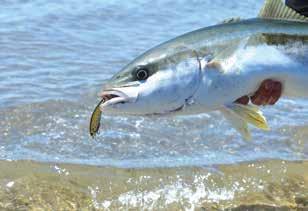

The plans for our family to join dad in Fiordland were all set, spending 4 days in March 2020 on board ‘Reel Image’.
The universe had other plans, and Covid restrictions meant we never got there.
Fast forward to midJanuary 2024, and it all came together. 3 generations of our family were equally excited about the long-awaited trip on board the new Image in the family, ‘On the Job’. Our biggest concern was how all 6 passengers, including 3 adult-sized teens, would fish, sleep and live on an 8.5m boat for 4 days. We need not have worried about that too much as we were far more interested in what was happening around the boat than in it.
Four of the family flew down and spent a few nights with family in Southland whilst Dad and I did a 26-hour road trip from Masterton to Manapouri. Once we were sure we had what was needed for our 4 days and essential supplies for the 15 other days that the next crews were going to be on board, we crossed the lake. It was warm and calm with beautiful scenery and our first introduction at the shores to sandflies.
They have a welldeserved reputation for being numerous and thirsty for blood. The teens were none too happy that this was going to be the reality of our time in Fiordland. Unless we were several hundred meters from the shore, then we were fair game for the biters.
Once we arrived at the end of the West Arm of Lake Manapouri, we checked out the visitor centre and learned a bit about the hydro station. There’s not much to see as most of the action is 200m below the lake surface, and visitors can no longer travel down the roads below. It was well worth the time and
Rachel Joblin
gave us some clues to what marine life we would be seeing once in Doubtful Sound. To get over the Wilmott Pass from the West Arm to Doubtful Sound was an adventure of its own. We booked a ride with a commercial operator who runs a truck with a trailer that can fit a wide range of boats. After loading, unloading and re-loading the boat onto the trailer, it was agreed that it was sitting pretty well and would cope with the 21km trip and 671m pass. The skill and care of the driver were evident as we wound our way up and then over the pass. The views of bush, waterfalls and even Chatham Island lilies were only outdone by the first glimpses of Doubtful Sound stretching in front of us. The first afternoon involved heading along the main sound. Rain had fallen the day before, and the waterfalls were putting on a show for us, so we took our time to appreciate them. We had no set plans and weren’t leaving Doubtful Sound, so we had all the time in the world. The first night, we enjoyed dinner far from shore to
avoid sandflies before mooring in Precipice Cove.
Day 2 was likely our only opportunity to head out into the open sea, hoping to hook some kingfish. We arrived at a lumpy sea that wasn’t going to be much fun. We found a spot near Cascade Bay that was somewhat sheltered, dropped the Minn Kota and enjoyed hooking a few goodeating fish, plenty of bucket mouths and a couple of small sharks that were suitable to eat. It didn’t take long until we had enough for a good dinner. After the excitement, it was time for lunch, several rounds of co ee, reading, and cards. Monopoly deal was the top game, and while the teens had a head start and had to teach the 3 adults, we gave them a run for their money. We spotted a couple of seals going about their day. The skipper was the only tank diver amongst us, so they took the chance in the afternoon for a dive. 20 minutes was plenty of time in the water to get crays for dinner to go with the morning’s catch. With the water beig only 140, it was probably long enough to be in the water too.
Sitting on the boat and watching the water depth, 24m deep and only 10m from shore, made me think about the underwater cli s and the glacial forces that created them. After an excellent dinner of fish and crays, we were back to monopoly deal and books before calling it a night in the tight sleeping quarters. Earplugs and patience were necessary but a small compromise for the incredible days of fishing we were all having. As we drifted o to sleep, we could hear light rain and knew the waterfalls would again be flowing well and put on a show the next day.
Day 3 dawned sunny, and it was a chance to get the little inflatable into the water and explore the Camelot River at high tide. With its little 2.5hp motor, we could travel 3 at a time. This side trip was one of my highlights with the clear water, mature bush and the knowledge that you were somewhere few people had ever been. The peacefulness with only 3 of us was timely after 2.5 days of cooking, sleeping and living shoulder to shoulder. My father has been to Fiordland 6
times for 3 or 4 weeks at a time and knows the place well. I think he has read every book written about Fiordland and proved to be an excellent guide and historian. Particularly as there was no way to Google anything.
Just as we had all boarded ‘On the Job’ again a 17m yacht arrived. They were hoping to travel up Camelot River in their runabout. We caught up with the 2 sailors in the early evening and shared stories and a coke on board their beautiful vessel. Their journey had brought them from Melbourne to the Bay of Islands, then down the west coast of New Zealand. Everyone was happy With coke and internet access via Starlink exchanged for crayfish. Our vessel had both a toilet and shower on board, but 2 of the teens braved the water for a swim and a wash. It was short and sweet, and the shower was used for a warm-up afterwards. We had all enjoyed day trips fishing on the boat before our Fiordland trip, but it was while it was our home we appreciated all the features, including
BBQ, freezer, hot shower, toilet, and clever storage for all our gear. And the bug screens on the windows and door! As we awoke to day 4, it was immediately apparent that it was colder than the other mornings. There was a coating of snow on all the mountain tops, and the air temperature was 40 degrees. Jackets were pulled out, and enjoying co ee on the deck while we took in the views was special. As this was the last morning on the boat for 5 of us, we had a bit of packing up to do before motoring back to Deep Cove. The snow-capped mountains on that last morning were another reminder that Fiordland is both exciting and beautiful yet unpredictable and wild.
After another fish meal for lunch, we disembarked ‘On the Job’. We quickly chatted with the incoming crew of 2 friends before waving them goodbye for another adventure. We headed back over the Wilmott Pass with the driver, who got us in there and cruised across Manapouri on the tourist boat. Our time on the boat was a unique opportunity and will be a time I cherish. All too soon, the teens will be busy with adult lives, and our captain will be less willing to give up his bed for us. Old Sea Dogs don’t give up the boat, and that’s why my generation had to have some boat towing and driving practice during the trip in preparation for future adventures.

When Rob Joblin decided it was time to upgrade his boat the choice of boat builders was a given. "Real Image" had performed so well and was at the heart of many fishing tales and family memories. A bit of a covid blip saw the dream delayed but January 2024 "On the Job" really was on the job. Taking extended family and friends on its maiden voyage to Fiordland. Rachel Joblin gives a great summary of the trip - sandflies and all - on the facing page.
But what about the boat build itself ?


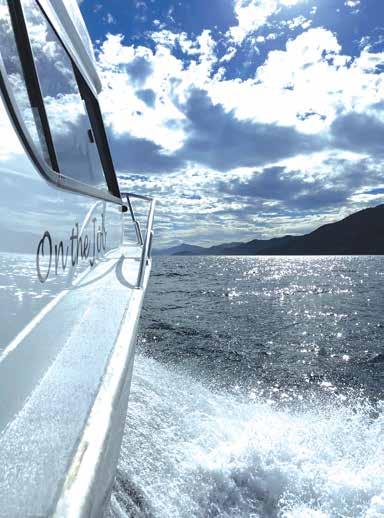

LOA 8.8m; Beam 2.8
Hull 6mm; transom
6mm; sides 4mm
17 deg deadrise
4 Rod Holders on gunnel
Boarding ladder & platform
Trim tabs
Lined cabin & wheelhouse
Sliding side windows
4 cup holders on bulwarks
Cage around back with rod holders
Bait board
Ladder on side of wheelhouse
Seating
Tread deck on bulwarks and bonnet
Walk through transoms
VHF
Electronics
NSS12 evo3S
HALO24 Radar
SS175H-W - Stainless Steel
1kW High-Wide-CHIRP Through Hull Depth/ Temperature Transducer.
SS175L - Stainless Steel
1kW Low-CHIRP Through Hull Depth/Temperature Transducer.
Minn Kota - an electric motor which keeps you anchored by GPS - so no anchor required- it always keeps head to the wind
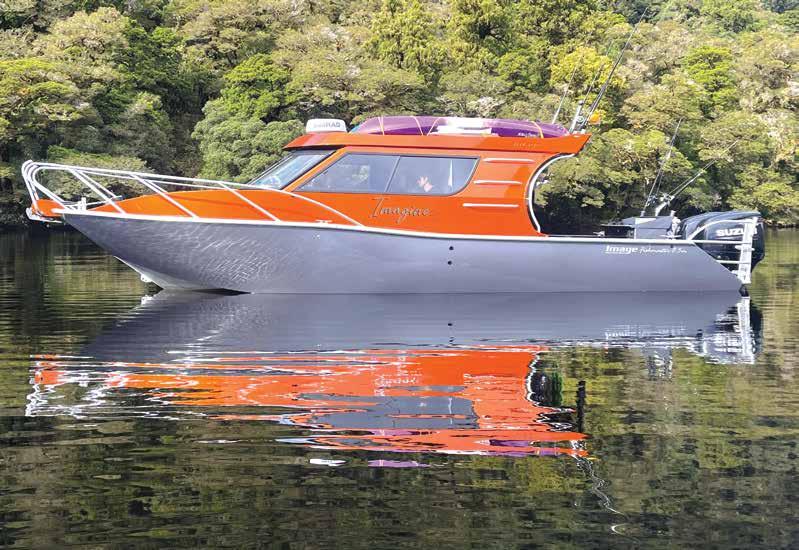
Motors Twin DF 200 APX
Extras
1 X 600 Litre fuel tank
1 X 300 litre fuel tank
Winch
Bunk bed
Fridge
Freezer installed under the seats - extending trip duration and allowing fish to be stored
Kitchen joinery
Stereo & Speakers
Rocket Launcher with additional rod holders
Shower cubicle with toilet, califont and rose
Oven
Stretch wheelhouse
2.4m inside
Table
Custom built Image
Boats Trailer, Heavy Duty
Under water lights
Water tank 200L
Live Bait Tank
Black Water Tank
Cage around transom with ladder
Solar Panels & Charger
Splash Back
Bi-fold Doors
Outriggers
Tuna Tubes
Small generator under seat so two 40V sources on board so that vacuum packing of fish and other activities could happen.
Boat roof extends unsupported over fishing area - great for shelter in all weathers
Image Boats Ltd, 24 Bay Road, Invercargill (03) 214 4573 M: 0274 368 055 E: admin@imageboats.co.nz
www.imageboats.co.nz
Image Boats Ltd - an Invercargill based boat builder of more than 23 years. They custom design and build 6m to 12m alloy boats for both pleasure & commercial use. These boats are highly personalised to the specific requirements of each customer.
We o er a stress free design process, complete in-house service including Fabrication & Fitout with full kitchen, sleeping for 5-6 people & separate toilet & shower cubicle. We also custom build trailers. Ride, Quality, Safety & Stability proven. Test Driven on the notorious Foveaux Strait. Local Dealer for Suzuki outboards.

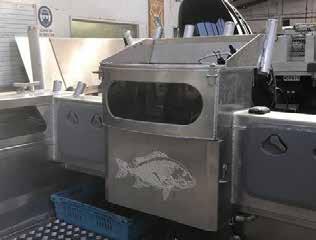

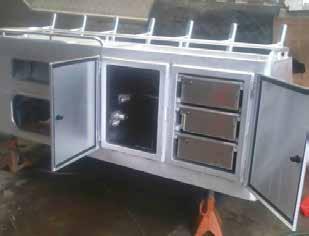



Over 30 years experience working with all types of metals, specialising in aluminium. What we do
• New boat builds
• Custom designs
• Repairs
• Modifications
• Trailers
• Marine projects
Our reputation speaks for itself, and our work consistently exceeds our customers’ expectations. Visit our website to see more.
morrismetals.co.nz
When you choose us, you’re choosing the best in the business Get in touch with us today
103 Nelson Street, Petone, Lower Hutt 5012 P 04 5689181 - enquiries@morrismetals.co.nz
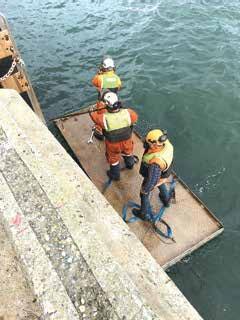

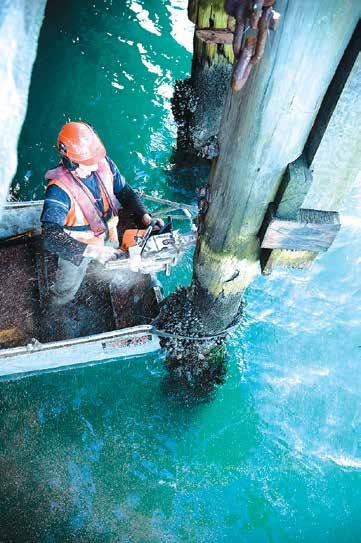

GK Shaw specialise in working in potentially high risk work sites in busy operational ports and public waterfront areas . The Flat bottom punts supplied by Morris Metals allow them to utilise a stable work platform to perform work alongside or under wharf structures.
Morris Metals Ltd have been building aluminium punts for use by the marine industry since the 1990's. Over the next few issues we will profile their usage in unique marine situations.

•
•
• Demos
•
•
• Guided Fishing Trips
•
•
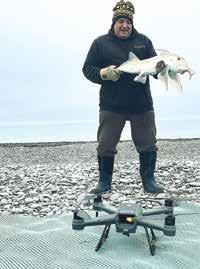

WE SPECIALISE IN HOSTING FISHING TOURS FOR GROUPS OF TWO TO SIX PEOPLE ALONG THE SPECTACULAR, RUGGED COASTLINE OF KAIKOURA, NEW ZEALAND Join
you have a memorable fishing experience while visiting Kaikoura. Also available Freediving trips - Take a kid fishing Ladies trips - Game fishing for Sharks CALL AND BOOK A TRIP TODAY Mobile: +64 21 843 908 Email: info@topcatchcharters.co.nz



•














The November 2023 issue of The Fishing Paper & Hunting News ran insightful articles about the previous Government’s last-minute Ministerial decisions on marine protected areas (MPAs) along the southeast coast of the South Island.
Fish Mainland’s article noted our concerns that stemmed from the Department of Conservation’s (DoC) control over the Southeast MPA forum planning process and the obvious failure to uphold fishing interests in the Ministerial advice and decisions.
We also noted our longstanding concerns about the MPA forum process had already been highlighted by the O ce of the Controller and Auditor-General https://www.oag.parliament. nz/2019/marine-environment
Recently we raised our concerns directly with DoC. Our concerns and DoC’s response are summarised as follows:
1. The MPA planning forum lacked recreational fisher representation.
• DoC alleged two unnamed forum members represented recreational fishers because they had some association with recreational fishing clubs.
• The fact is the first was kicked o the forum and the second was out of his depth. Neither engaged with fishers due to them having been muzzled. DoC denies forum members were muzzled.
• In short, DoC fails to grasp representation requires a representative to be selected by those who will be represented. Instead, DoC hand-picked those who would produce desired outcomes.
2. DoC failed to listen to the views of recreational fishers.
• DoC rightly stated during 2016 and 2018 consultation the views of recreational fishers were documented, and these views may have aided changes in some
proposed MPA sites.
• Surprisingly, DoC also replied the forum role and process ceased once MPAs were proposed.
• We were unaware, as were some forum members, that DoC alone was to consider the 4000+ submissions received in 2020 and formulate Ministerial advice. That aside, at no time did DoC seek any clarification or further input from fishers.
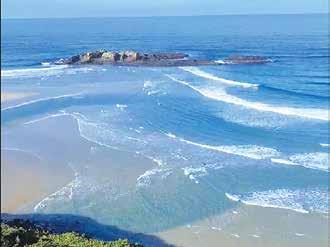
3. The public remained unaware of comanagement negotiations with Ngai Tahu.
• DoC acknowledged engagement with Ngai Tahu continued during 2020 consultation and afterwards, but failed to explain why the public still has not received any explanation of comanagement or Iwi access to the MPAs. Why the continued silence?
4. DoC failed in its due process and natural justice obligations.
• We contend these obligations were not met with DoC simply having considered recreational fishers’ views and rather flippantly rejected all of them in the
Randall BessMinisterial advice.
• Consultation is defined as providing for the public to inform and assist in decision making. There have not been any opportunities to assist, nor comment on any Iwi negotiations, post-2020 consultation.
5. The October 5, 2023, Ministerial decisions on MPAs breached the caretaker convention.
• While DoC correctly responded the government is not bound by the caretaker convention during the pre-election period, it was taken out of context.
• DoC omitted reference to the longstanding practice of ensuring all significant matters that will require ministerial attention during the election year are dealt with well in advance of a general election (Cabinet O ce Circular 23(1)).
• In short, the Ministerial decisions were announced after voting began, which was unprecedented.
• Public servants are not neutral in their work; they have self-interests, and they are vulnerable to their work leading to public-spirited zeal for certain policy outcomes.
• Those who work at DoC are especially prone to zealousness because DoC’s statutory purpose includes advocacy, unlike other agencies.
Nonetheless, increasingly policy outcomes are being defined by Ministers, and it is in the self-interest of public servants to exact obedience to them.
We encourage the new Minister of Conservation to reject past Ministerial decisions on Southeast MPAs and direct DoC to work collaboratively with the fishing sectors, not just with Ngai Tahu.



Pulsar have incorporated updatable Firmware on many of their products, enabling users to update their device with new features and improvements. The latest update for Thermion 2 and Trail 2 models is an outstanding upgrade that indicates precise holdover.
Firmware is the operating system that controls image processing, internal and external control functions. Updates are free through the Stream Vision App for smartphone or tablet, which is available from Google Play or Apple Store. Whenever you link your device to Stream Vision, its Firmware is confirmed as either the latest or if an update is available.
Pulsar Stream Vision Ballistic App. This App. provides accurate projectile point-of-impact (P.O.I.)

at di erent ranges, using info from a vast array of factory and customisable loads, combined with other factors such as barrel length and twist, scope height and ambient temperature. This info is useful for all shooting, but Pulsar have taken this technology further with a Firmware update that enables saving ballistic profiles onto their thermal riflescopes. The ballistic profile is used to move a P.O.I. marker to precisely show holdover.
Updating the new Firmware on Pulsar Thermion 2 LRF and Pulsar Trail 2 LRF thermal riflescopes uses the distance and inclination angles of ranged objects to move the P.O.I. marker to provide quick and easy holdover (or under). Multiple Profiles can be stored for di erent loads and rifles, which are selectable from within the menu. When used with nonLRF models
Riflescopes without an inbuilt laser rangefinder
work in the same way, except distance is manually set by tapping and turning the control dial. Accurate distance measurement is established with a hand-held rangefinder. This new feature has a host of uses, from recreational meat hunting to professional pest control, at long range or with low velocity rifles and crossbows. It improves shooting e ciency and ensures more humane kills.

again once you’ve explored in Jayco’s

For more information about Stream Vision and Stream Vision Ballistics, visit www. advancedoptics.nz
Jayco’s motorhome division has been going from strength to strength in recent years and 2024 brings a brand new layout on the ever popular Iveco Daily chassis, which is destined to be one of the most popular.
A proven platform that is built for reliability, comfort and customer enjoyment. The Iveco Daily Conquest Motorhome can be driven on a passenger car licence and is designed for a fast and easy setup with fantastic storage options, including a large rear storage tunnel. This gives plenty of storage for the dive gear, fishing rods and BBQ. Even more storage above the cab and a huge payload means you can be well prepared for long stays on the road.

The Iveco Daily Conquest Motorhome ensures that tourers can get the most out of their holiday with a 3500kg flat tow rating so owners can take their car with them on the road or even tow the jet skis.
With an island double bed, separate shower and toilet and L-shaped dinette, the Conquest is designed for your next great escape and
also includes standard air conditioning, an awning, a fridge and a roof-mounted 200W solar system with the ability to upgrade the power system to suit your needs.
For those who want a rear wheel drive motorhome with tonnes of power and all the usual Jayco comforts, the Jayco IV26.1 is in stock now at Jayco Canterbury.
Get in touch at sales@jaycocanterbury.co.nz and take advantage of the great deals on o er today
https://jaycocanterbury.co.nz/


MERGING CLASSIC DESIGN WITH ADVANCED TECHNOLOGY
The Pulsar Merger LRF thermal binocular delivers a comfortable, immersive viewing experience with enhanced detail rendition. Viewing with both eyes also reduces eye fatigue during prolonged observation periods.
Pulsar Merger LRF common features
• 1000m laser rangefinder
• Lynred STD-810/833 TWS Qualified sensor
• Supplied with an APS3 battery and charger
• Quick-change battery with internal back-up battery adds significant operation time
• Tough waterproof magnesium alloy housing
• Overidable proximity sensor
• ¼” tripod mount
Three models available to suit various budgets and operational requirements.
Merger LRF XQ35
All the great features of its high-end siblings. Compact, great image quality, fog, rain and foliage penetration. Excellent value.
Merger LRF XP50
The most popular Merger combines fine image detail with deep fog, rain and foliage penetration. The best all-round Merger for Pros and hunters.
Merger LRF XL50
The ultimate thermal offers a very wide field-of-view, amazing image detail and high magnification zooming capability.

11 February was the International Day of Women and Girls in Sciencea day dedicated to recognising the important contributions women have made in science and technology, and to encourage women and girls into pursuing a career in STEM.
Fisheries New Zealand is lucky to have many women involved in scientific work and, to celebrate the day, we’ve profiled Dr Marine Pomarède, Principal Scientist in our stock assessment team.
Marine discovered a passion for science on a trip to Canada to visit her uncle when she was around 9 years old.
“While on a whalewatching tour, we saw some beluga and I wanted to understand what they were saying to each other. I didn’t necessarily want to be
able to communicate with them, but just to understand their language.”
This idea stuck with Marine and led her to


focus her studies on, aptly, marine science. During her Bachelor of Science degree, Marine discovered modelling, “on a computer rather than a catwalk”, which led her to a new focus of combining marine science with statistics.
In Marine’s role at Fisheries New Zealand, she leads our shellfish science, focusing on the status of shellfish stocks around the country. This involves a lot of time in front of a computer, and many online meetings with stakeholders and others in the science world, to develop and manage research programmes. While most of her work keeps her indoors, she has had the chance to get out of the o ce for hands-on research, including on NIWA’s Tangaroa research vessel for an acoustic hoki survey, taking part in a biomass survey of oysters in Foveaux Strait, and
to a Northland beach to survey cockles and pipi to estimate their abundance and density.
“What I really love most about my work is the people. I work with scientists, fisheries managers, iwi representatives, commercial fishers and many more. The discussions are very varied but all focus on doing our best to get the best science to manage our fisheries.”
Marine also has some advice for women and girls considering a career in science:
“Go for it! It is challenging, exciting, rewarding, empowering, and fun! Go and talk to scientists in the fields you’re interested in to learn more about what they do. See if you can spend a day with them so you can see how they work. Do internships. Get some experience. Trust yourself.”







Saturday, and although retired, to me, it still seems like the day to go do things – I went fishing. Hit the road at gentlemen’s hours (misnomer?) and was lakeside just after nine, with nobody else there, even on a Saturday. It could’ve been the conditions. In contrast to most other people, my eyesight has improved with age, as I can now actually see the breeze. I didn’t like the look of the wind blowing in from the East at all. Yeah, the East – might as
some reeds so in I went. It was shallow, with the lake down a bit, but almost immediately, I spotted a fish, and it also spotted me before it fled the scene, topping out at around 200 kilometres an hour past the boat. I managed to get the fly jammed in a lump of sunken wood –possibly from a wellknown agency’s willow poisoning programme some years back. Bye-bye fly, but they’re still making them so onward and upward. I moved around to
hopes about to be dashed? Suddenly, I felt a cold pu from the other direction, bringing a slight frisson of gloom as I contemplated the whole scenario, repeating from the opposite direction. However, it was only the vast bulk of Mount Te Kinga playing its old trick of moving wind around at its whim. Happily, it came to nothing, and the day settled down. I spotted another fish cruising along the bottom, but it emulated the first one I’d seen.


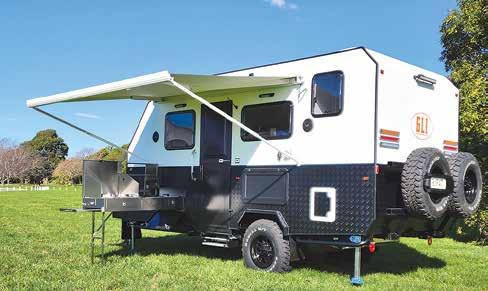


well have taken along a crate of bananas!

However telling myself it’s silly superstition, I launched, motor started first pull and Silver Frog chugged quietly to the first spot. The wind made its presence felt, and it was apparent it would be a major player for the day. It was impossible to keep the boat where it was needed; it was blown around like teacups on a Disneyland ride, so there was consideration of pulling the plug, but drawing on some Irish pig-headedness, persistence became the name of the game. Finding a section out of the wind behind
where I thought there might be more shelter, and the breeze even helped a bit by moving the boat along the shoreline, albeit at 2 knots, so a few quick casts were possible. I noticed the wind began to stop for brief periods, so fingers, toes, and nose were crossed in the hope of a cessation of its' hostilities. It did return from time to time with foul exhalations, but the calm breaks were becoming longer and the sun continued to shine. Gusts became lighter, then settled down to a gentle light that was very manageable, as I worked through a reach of the lake that had been kind to us before. But were my
Coming to one of the many nooks and crannies I've delved into over the years I muttered to myself ”there’s always one mooching around here.” As the words escaped my lips, bang, I was in, and then out. Was it a briefly slack line or just two fickle fingers of fate waggling at me? Much more of this could give one a complex leading to many weeks and a small fortune, getting the noodle back to sanity.
Like aging, fishing is not for the fainthearted, so how did this day end up? Tell you in the next column – oddly, it did have a happy ending, though.
China remains the largest consumer of New Zealand rock lobsters – over 2000 tonnes per annum of live product landed at key ports in mainland China in recent years. The Spring Festival / Lunar New Year period arrived in late January and ran through to mid-February 2024.
Up to sixteen special days for enjoying time with loved ones and, most importantly, feasting! Seafood has a special place on the banquet table, with fish used as a symbol of abundance, meant to give a good start to the new year.
2024 is the Year of the Dragon, adding another association with seafood - the spiny rock lobster, with its fearsome dragonlike whiskers and auspicious red colour. Dragons are bringers of wealth and good fortune, so they are the epitome of what Chinese New Year is all about, a celebration of luck and good fortune for the coming year.
Airport; after arriving at the Capital Airport Customs Inspection Centre. The whole process takes less than 20 minutes for the sta to check the cargo certificate, open the box for inspection, and quarantine and release; before 12 noon, these lobsters can be put into the fish tanks of the Beijing-Shenzhen Seafood Market.”
Moving live rock lobsters from the many small fishing ports around the New Zealand coastline into discerning export and domestic markets (China is not the only one) requires a duty of care by everyone in the lengthy chain of custody. Fishermen, transport personnel, processing sta , packers, loaders and freight forwarders are required to work to high standards in a very timely and e cient manner. This in turn ensures that lobsters unloaded from fishing vessels, trucked to depots, held in an export facility in Auckland before being packed and loaded to an international airline.

People’s Daily reports from Beijing on the growing role of imported products in satisfying Spring Festival demand, citing the journey of New Zealand rock lobster to market: “At 8:50 p.m., a batch of fresh lobsters with a total weight of 754 kilograms was shipped and took o at Auckland International Airport in New Zealand; at 5:10 a.m. the next day, the batch of lobsters landed at the Capital
continuity of supply is embedded in the operation of the New Zealand fisheries management regime. Routine monitoring of stock abundance, confirmation of commercial catch limits, and restrictions on gear types helps to maintain stock abundance over time. Fisheries regulations relating to the handling
also anchor quality standards for the production of all New Zealand seafood. Animal Welfare Regulations apply to lobsters held in processing and export facilities and those being transported and/ or packed for transport to overseas markets.
The regulations extend to restaurants and other food service outlets with a strong

behaviour of rock lobsters contribute to their suitability for live markets. Pre- and post-moult lobsters can be weak and have discoloured flesh. Have you noticed ‘pink’ lobsters in your own pots? Lobsters will be down-graded if they have two legs missing on each side or three or more missing on one side.
Cracked or broken shells and any section of the horn missing are not acceptable – but broken antennae whilst not ideal, will survive the quality grading test. The value chain for rock lobsters commences with the first pot haul of the day. Catches are immediately sorted, and all under-sized or otherwise unwanted catch is returned to the sea – always in a suitable habitat. Air exposure at any time will stress the lobsters but is sometimes unavoidable. Sun, wind and rain exposure, even short-term, exaggerates this stress. Pots cannot be banged around or dropped whilst clearing lobsters – every e ort is made to avoid shell damage or leg loss.

taken not to over pack bins and to keep them shaded and cool. Bins are weighed, loaded and transported to the relevant Licensed Fish Receiver, where lobsters are unloaded, graded, weighed and transferred to holding tanks for ‘conditioning’ prior to being packed for export or distributed to the local market. At every step of that process, operational standards are established, and quality checks are frequent.
In Chinese culture, the dragon has significant symbolism and is revered. It represents positive qualities such as power, strength, good luck, and wisdom. The Chinese dragon is considered a celestial and divine creature with the ability to control natural elements such as wind and water. The Year of the Dragon is anticipated to bring auspicious opportunities and exciting advancements for all.
The same attention to detail underpins supplies to the New Zealand domestic market and hospitality industry.
Lobster fishermen take the quality standards very seriously – the financial incentives to land only export grade product can be very generous –but even before a lobster is handled on board the boats, the consumer guarantee of sustainability and
and discarding of undersized and/or soft-shelled lobsters set a baseline standard for the size and quality of the landed catch. General food safety and animal welfare obligations must also be observed. For example, the New Zealand lobster industry operates a national Biotoxin Management Plan with strict protocols in place to ensure that there are no risks to domestic or export consumers during biotoxin events such as those that prevented the CRA 3 (Gisborne/East Coast) industry from landing catches for several months in the 2023/24 summer. Safe operating procedures for all commercial fishing vessels and work and safety best practices for skippers and crew
message that live seafood must be looked after to ensure good quality and safety.
The economic value of New Zealand live lobster production is balanced on the quality of each lobster handled by every commercial skipper and crewman. Quality is measured by both ‘liveliness’ and appearance. The lobster with all legs and antennae unbroken (both desirable traits) will fail the quality test if it is not lively or su ciently hardshelled. But the obviously active lobster with a strong shell that keeps leaping out of the bin on the boat could be of low value if legs and antennae are broken o because of rough handling and storage.
The biology and
Catches will generally be stored in on board live holding tanks with reticulated seawater temperatures maintained at generally recommended 10C to 18C. Holding tanks are oxygenated by controlling the flow and volume of seawater.
Fishermen also use holding pots at sea to store their catches until they can arrange a landing to a Licensed Fish Receiver. Attention is given to the design and placement of the holding pots and to the stocking rate. Holding pot catches are transferred to the vessel to be unloaded at the wharf along with the catch taken on the trip. Care is
As vibrant hues adorn streets and the tantalizing aroma of traditional delicacies wafts through the air, Chinese New Year 2024 heralds a time of renewal, prosperity, and cultural celebration. Ushering in the Year of the Dragon in 2024 provided a perfect opportunity to extend warm wishes, heartfelt messages, and inspiring quotes to loved ones, friends, and colleagues. New Zealand rock lobsters were centrepieces at those family and o cial celebrations and are very highly regarded as a premium seafood item.



